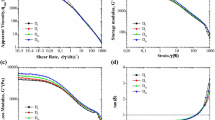Abstract
The present research was undertaken to explore the significance of structuring/prebiotic blends on bread dough rheological performance during mixing, fermentation, resting, cooking and cooling stages of breadmaking simulation. Carboxymethylcellulose and locust bean gum, and prebiotic oligosaccharides were used to replace wheat flour at 10% substitution level. The impact of fibre replacement on bread dough linear and nonlinear rheological/functional performances was investigated by mechanical and thermo-mechanical approaches. Dietary fibre effect on dough microstructure was also studied. Significant variation among samples in terms of dough strength as a consequence of the different structuring agents used was found. Neither inuline nor gluco-oligosaccharides were able to modify the general trends marked for carboxymethylcellulose and/or locust bean gum. Reported data suggested the feasibility of locust bean and carboxymethylcellulose, as thickening and structuring agents for baking industry. The microstructure of control bread dough with no added fibres differs greatly from that of structuring/prebiotic supplemented samples.




Similar content being viewed by others
References
Burey P, Bhandari BR, Howes T, Gidley MJ (2008) Crit Rev Food Sci Nutr 48:361–377
Selomulyo VO, Zhou W (2007) J Cereal Sci 45:1–17
Redgwell RG, Fisher M (2005) Mol Nutr Food Res 49:521–535
Gibson GR, Roberfroid M (1995) J Nutr 125:1401–1412
Collar C (2008) Chapter 9. In: Hamaker BR. CRC Press, Boca Raton
Autio K, Salmenkallio-Marttila M (2001) Food Sci Technol 34:18–22
Dobraszczyk BJ, Morgenstern MP (2003) J Cereal Sci 38:229–245
Collar C (2003) Eur Food Res Technol 216:505–513
Collar C, Bollain C, Rosell CM (2007) Food Sci Technol Int 13(2):99–107
Angioloni A, Collar C (2008) Food Res Int 41(8):803–812
Angioloni A, Collar C (2009) J Food Eng 91:526–532
Angioloni A, Collar C (2009) Food Hydrocoll 23:42–748
ICC (1976–1996) Standard methods of the International Association for Cereal Chemistry. 104/1, 105/2, 107/1, 110/1, 115/1, 121, 136, 155 and 162. The Association, Vienna
Hoseney RC, Chen WZ (1994) US Patent 5,280,616
Armero E, Collar C (1997) Z Lebensm Unters Forsch 204:136–145
Collar C, Martínez JC, Andreu P, Armero E (2000) Food Sci Technol Int 6(3):217–226
Smewing J (1995) Stable Micro Systems Ltd, Surrey
Peleg M (1979) J Food Sci 44:277–281
Peleg M, Pollak NT (1982) J Texture Stud 13:1–11
Singh H, Rockall A, Martin CR, Chung OK, Lookhart GL (2006) J Texture Stud 37:383–392
Robertson GH, Cao TK, Wood DF (2000) Cereal Chem 77(4):439–444
Collar C, Bollain C (2005) Eur Food Res Technol 220:372–379
Bollaín C, Angioloni A, Collar C (2006) J Food Eng 77(3):665–671
Sliwinski EL, Kolster P, van Vliet T (2004) J Cereal Sci 39:231–245
Rosell CM, Collar C, Haros M (2007) Food Hydrocoll 21:452–462
Xiaohong S, BeMiller JN (2002) Carbohydr Polym 50:7–18
Gan J, Rafael LGB, Cato L, Small DM (2002) Proceedings of the 51st Australian Cereal Chemistry Conference, pp 304–308
Cato L, Rafael LGB, Gan J, Small DM (2002) Proceedings of the 51st Australian Cereal Chemistry Conference, pp 304-308
Gallagher E, Gormley TR, Arendt EK (2004) Trends Food Sci Technol 15:143–152
Lazaridou A, Duta D, Papageorgiou M, Belc N, Biliaderis CG (2007) J Food Eng 79:1033–1047
Acknowledgments
Authors acknowledge the financial support of the Ministerio de Ciencia e Innovación (Project AGL2008-00092/ALI).
Author information
Authors and Affiliations
Corresponding author
Rights and permissions
About this article
Cite this article
Angioloni, A., Collar, C. Significance of structuring/prebiotic blends on bread dough thermo-mechanical profile. Eur Food Res Technol 229, 603–610 (2009). https://doi.org/10.1007/s00217-009-1090-4
Received:
Revised:
Accepted:
Published:
Issue Date:
DOI: https://doi.org/10.1007/s00217-009-1090-4




